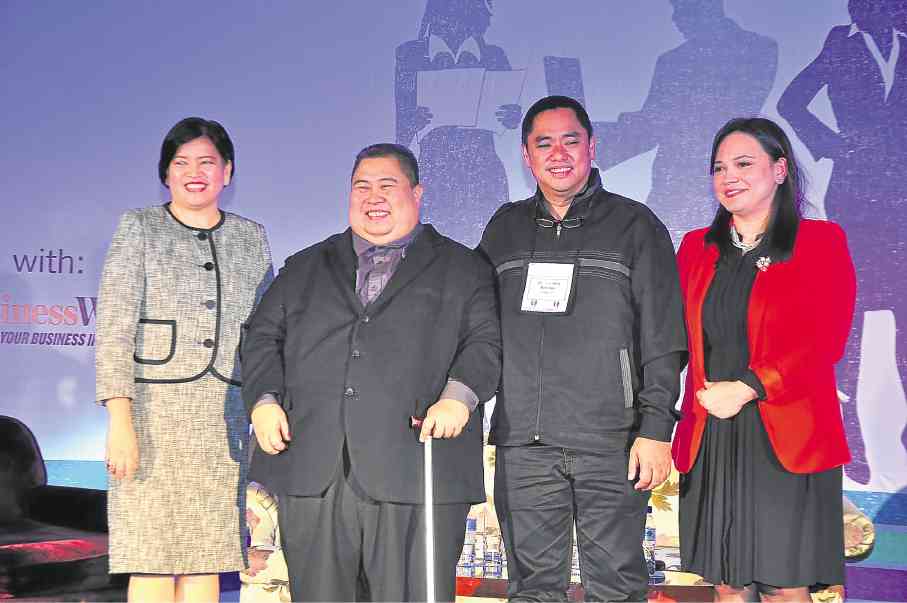
PEOPLE PERSONS. (From left) P&A Grant Thornton CEO Marivic Españo, UP Diliman professor Virgel Binghay, PLDT head for employee development Nonong Noriega and P&A Grant Thornton People and Culture Director, Rhia Dee
In a world where industries are investing more in technology and becoming increasingly digital, a professional services firm reminds companies not to lose sight of their most important asset: people.
At their sixth business forum held recently in Makati, tax, audit, advisory and outsourcing company P&A Grant Thornton held discussions on “People as a Strategy: Capitalizing on People to Promote Business Growth.”
“Coming from our own experience as a service firm, we look at [our] future and the different drivers of our business. What makes us successful, grow, and improve the value that we give our clients. The core of all these things—what [and] how we deliver to clients, how we implement processes—would be people,” said P&A Grant Thornton Philippines chair and CEO Ma. Victoria Españo.
“All businesses are in the same boat; whether you’re in manufacturing, or are a conglomerate or a small company, all the best intentions, the best strategies—expanding your services, technology advancements—your people will be implementing them. The question is, does the organization have the right people? [And] is it developing the right people to support its strategy, which would be implemented 20 years down the road?” she added.
The forum’s speakers included: Grant Thornton International’s Olivia Gadd, Accenture Inc.’s Lito Tayag and Oxford Business Group’s Paulius Kuncinas, who talked on Acquiring the Right Talent; People Management Association of the Philippines’ Josephus Jimenez, Institute of Training and Development’s Serely Alcaraz and NEC Philippines, Inc.’s Agnes Gervacio, who touched on Diversity and Inclusion; University of the Philippines professor Virgel Binghay, PLDT’s Nonong Noriega and P&A Grant Thornton’s Rhia Dee, who discussed Human Capital Standards and Analysis.
One way for companies to maximize their people, said Binghay, is to hire HR analysts who can “make use of analytics or big data to forecast trends and issues regarding personal problems and opportunities, strategically improving people management results from labor costs.”
Such function would involve the analysis of the correlation between a company’s employee data and its sales and finance data.
These “big data” could potentially help companies “identify who would most likely stay, be promoted, thrive in certain environments, or be motivated by so-called non-hash rewards,” Binghay added.
As to hiring and keeping the right kind of employees, Gadd dished out a few tips: Identify the right talent for your future; understand your audience, and speak to them through your own people’s experience; identify and articulate your value proposition and purpose—beyond profit; and understand what motivates people, including pay.
Finally, Jimenez, whose presentation also focused on the Philippines’ labor laws, correlated workplace inclusion to the country’s peace and order situation.
“We still have a lot of inclusiveness laws, embracing diversity in the workplace. Even those who are HIV positive or suffering from disease cannot just be dismissed. So this country does not discriminate—on principle. However, there are many companies who are doing things contrary to this principle. So what is the prognosis? The country still has a long way to go,” said Jimenez.
Españo said she hoped such discussions would help change the “traditional” mind-set of companies—their clients included—when it comes to handling their people.
“The more progressive companies really take care of [their people]. But in general, I think the approach [here in the Philippines] is still traditional: anything to do with people, let human resources take care of that,” said Españo.
“But these are the questions we should be asking: Is this just a fluke? Is there something wrong with our processes? Is there something wrong with the way we develop our people? For that to happen, management must be able to see that people should be part of any [business] strategy.”